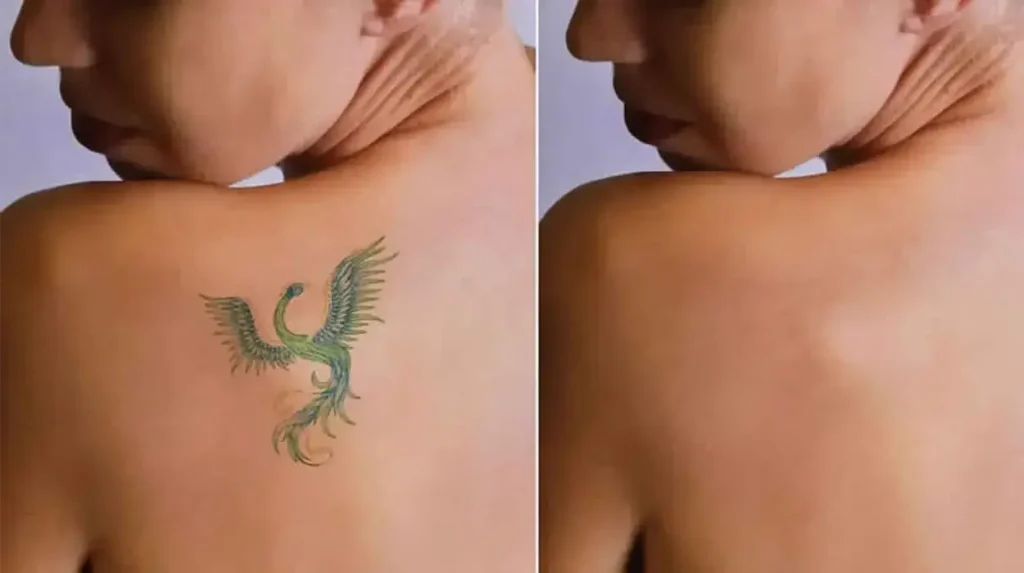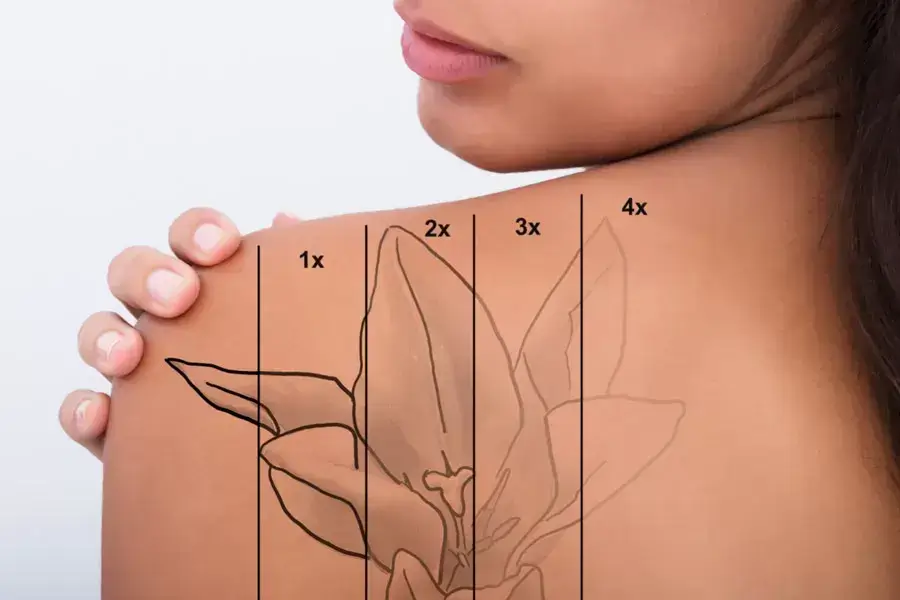In every moment of inspiration, a tattoo might seem like a brilliant idea. Yet, as fickle creatures, our opinions and attitudes often change over time.
What once was a cherished piece of inked imagery or words may no longer fit the person we’ve become.
This is where laser tattoo removal comes into play, offering a solution to those seeking to erase the reminders of the past.
The pressing question for many is, “how long does laser tattoo removal take?” That’s what we’ll discuss in this guide.
Also Read: Will Laser Tattoo Removal Damage My Skin? Get The Facts
What Is Laser Tattoo Removal?
Laser tattoo removal is a process aimed at extracting tattoo ink from beneath the skin to reveal the clear, natural skin underneath.
A significant portion of the US population, at some point, finds themselves regretting a tattoo decision.
Instead of living a life filled with regret, many are now turning to laser technology to remove these permanent memories for good.
Why Do People Get Tattoos Removed?
Individuals remove tattoos for a variety of reasons, often aligning with the original reason they got the tattoo.
Whether to commemorate significant times, people, or beliefs, or from a whim without much thought, the change in personal context or values provides a compelling option to change the outside to reflect the inside.
It’s a common decision to remove a tattoo that no longer represents who they are.
1. Change Of Heart
A change of heart, especially after a breakup, can make a tattoo of a love interest’s name or symbolic representation of a romance feel sour, prompting tattoo removal as a remedy.
2. Shifting Values
What we want at 18 can differ greatly by middle age. Changes in beliefs, religion, affiliations, or general attitude make some tattoos undesirable or offensive, leading them to be commonly removed.
Also Read: How To Remove Tattoos At Home With 13 Proven Methods
3. Business Casual
In many work environments, tattoos are not viewed favorably, prompting individuals to remove tattoos to enhance their professionalism or to find work more easily.
4. Aesthetic Dilemma
Tattoo techniques have improved over the years, but older tattoos that haven’t aged well or didn’t turn out as wanted due to misspellings or subpar tattooing technique often lead to tattoo removal.
5. Time Travel
Tattoos serve as reminders of times, places, people, and feelings that some wish to forget. The constant reminders on their skin drive them towards the freedom offered by the tattoo removal process.
How Long Is a Session?
A typical tattoo removal session can last anywhere from five to thirty minutes, depending on the size of the tattoo and the removal process used.
For those visiting to remove multiple tattoos, sessions can be longer or shorter, tailored to how many tattoos you’re getting removed.
Can A Tattoo Be Removed In One Session?
Removing a tattoo in one session is a possibility for small, faint tattoos, but not guaranteed.
The process, time, and effectiveness depend on the tattoo’s size, coloration, depth, and age.
Laser effects might not be noticeable after just one session, making results vary.
Treatment may be sufficient for some, but achieving aesthetic goals often requires more than one treatment.
Are Some Tattoos More Difficult To Remove Than Others?
Indeed, dark and deep tattoos are more difficult to remove compared to lighter tattoos. They often take on a blurry shape before fading.
Different colors respond uniquely to laser pulses, which is why the Cutera Enlighten technology is utilized to effectively target various ink hues.
Also Read: Can Laser Tattoo Removal Cause Nerve Damage

How Long Does Laser Tattoo Removal Take?
The process duration takes into account the client’s specific tattoo or tattoos scheduled for removal.
Clients’ needs are addressed on an individual basis, with in-person consultation used to assess the skin and tattoos for detailed information.
A treatment plan is then tailored, usually requiring three to six sessions to remove a tattoo.
The entire area must heal properly between sessions, leading to a 12 to 24 weeks timeline on average for tattoo removal.
Clients with larger tattoos, more tattoos, or special ink may face an extended treatment duration, though average results may be seen in fewer treatments as tattoos variably respond to laser technology.
1. Skin Tone
Skin tone significantly affects the laser removal process.
Lighter skin tones allow for easier removal of ink particles, as the laser can target the ink more effectively due to greater contrast.
Conversely, darker skin tones may require a longer duration to achieve similar results.
2. Tattoo Location
The Tattoo location plays a crucial role in the removal efficiency.
Tattoos closer to the heart and areas with a high lymph node count, such as the face, neck, chest, upper back, and arms, are removed more quickly and effectively.
Tattoos on the lower body, where there’s less blood flow and fewer lymph nodes, take longer to remove.
Also Read: Is Laser Tattoo Removal Painful
3. Ink Types
Ink types also influence the removal process. Since tattoo artists often mix their own inks, the pigment and compounds used can vary in how receptive they are to laser removal, affecting the rate at which a tattoo is removed.
4. Aftercare
Aftercare is pivotal in determining how quickly and effectively a tattoo heals post-laser removal.
Proper care of the tattoo after treatment minimizes scar tissue formation, which can make subsequent removal sessions more difficult and longer.
5. Age Of Tattoo
The age of tattoo impacts removal time; older, faded tattoos generally require less time to remove compared to newer tattoos, as they degrade and sink into the skin over time.
6. Depth Of Ink
The depth of ink deposited within the skin—whether professionally deep or superficial as in stick-and-poke or amateur tattoos—affects how long the removal will take.
Professionally inked tattoos are bolder but take longer to remove.
7. Size Of Tattoo
The size of the unwanted ink is a significant factor in how quickly it can be removed. Larger tattoos naturally require more time to fully erase.
8. Color Of Ink
Color of ink plays a crucial role, with lighter colors being removed more slowly than darker colors due to laser removal technology’s contrast reliance.
Dark ink on light skin is the easiest to remove, whereas light-colored ink, like yellows, greens, and blues, are difficult to remove, necessitating longer treatment times despite the advancement in lasers.
9. Immune Health
Immune health significantly impacts the laser removal session’s effectiveness.
A healthy immune system processes shattered ink particles more quickly, whereas a weak immune system may slow down the removal process.
Also Read: How Does Tattoo Removal Work
10. Smoking Cigarettes
Smoking cigarettes notably reduces the effectiveness of tattoo removal, with smokers having a 70% lower chance of successfully removing their tattoo over a ten-session period, compared to non-smokers.
Stopping smoking can improve removal sessions’ success rates.
11. Sun Exposure
Sun exposure can make a tattoo more difficult to remove.
Sunburned skin or a recent tan complicates the laser treatment process, suggesting patients stay out of the sun or fully cover the treatment area to ensure optimal removal conditions.
How Does Laser Removal Work?
Laser removal operates through quick pulses of light energy that penetrate the skin and are absorbed by ink particles.
This energy causes the ink to shatter into tiny ink fragments, which are then cleared away by the immune system’s macrophages.
Each laser removal session allows practitioners to target specific areas of the body where the tattoo is located, utilizing lasers that emit a continuous beam of light in short bursts to effectively break down the ink.

The Importance Of Q-Switching Lasers
Q-switched lasers are crucial in tattoo removal for their ability to emit powerful pulses of energy in nanoseconds.
The light energy, once absorbed by an ink particle, converts to heat energy.
This fast pulse ensures the energy is absorbed efficiently by ink particles without damaging surrounding skin cells.
The pulse of energy causes ink particles to break apart due to the hot and cool forces within the particle itself, making it a key technology in laser tattoo removal.
Also Read: Can You Get Laser Tattoo Removal While Breastfeeding
Targeting Tattoo Ink
The laser removal process efficiently targets ink particles to absorb light energy, crucial for breaking down the ink.
This process relies on the reflection and absorption of the light spectrum, where white light contains all colors of the rainbow, visible when passed through a prism.
An object appears green because it absorbs all wavelengths of color in the light spectrum except for green, which it reflects.
Similarly, green tattoo ink does not absorb green laser light but is best targeted by a red wavelength.
The PiQo4 laser offers four wavelengths of visible light to target and remove various ink colors from the skin.
The Immune System’s Work
Once ink particles are shattered into smaller fragments, the immune system’s macrophages grab and move them to the nearest lymph node to be flushed from the system.
This process necessitates a wait of 6 to 8 weeks between laser tattoo removal sessions to allow for fragmented ink particles to be removed from the area.
If a laser removal session is conducted too soon, it can impede the removal of deeper ink particles.
What Happens After Each Session?
After getting a tattoo removed, the treated area is dressed with a bandage, and instructions are provided on how to protect the area in the coming days. Itching may occur as the area heals.
Will The Tattoo Be Fully Gone?
Achieving 100% clearance of a tattoo is not guaranteed, with most clients seeing a 90-95% pigment eradication.
Tattoo ink is unregulated by the FDA, meaning the treatments and the immune system’s ability to process the ink vary significantly from tattoo to tattoo. Results also vary from person to person.
While a completely removed tattoo might be the goal, 90-95% pigment eradication often renders the tattoo virtually invisible to those not aware of it, such as casual acquaintances at the grocery store or dinner.
However, a best friend, co-worker, significant other, or family member may still spot very small, faded flecks of pigment—a phenomenon known as ghosting.
Despite this, such an outcome is considered an acceptable level of removal for most clients who are candidates for full tattoo removal.
This level of success means that a permanent decision can be effectively 90-95% gone, as evidenced in after photos where remaining pigments are barely noticeable.
Also Read: Do Color Tattoos Take Longer To Heal

FAQs About How Long Does Laser Tattoo Removal Take
1. How Quick Is A Tattoo Removal Treatment?
Laser sessions can be surprisingly fast, with some treatments taking less than 3 minutes and others as quick as 15 seconds. This real-time tattoo removal showcases how quickly a tattoo can be lasered.
2. What Results Can Be Anticipated After Laser Tattoo Removal After 3 Sessions?
By Session 3, clients often observe significant fading of their tattoos, with some elements nearing a “fully” faded state, marking a pivotal appointment in the full removal experience.
3. How Long Does Laser Tattoo Removal Take To Heal?
Post-removal, blisters and scabs typically form within 12 hours, requiring about a week or two to heal. Complete healing of the skin, turning pale or pink, may take six to eight weeks.
4. How Long Does It Take To Remove A Small Tattoo?
The removal of a small tattoo generally necessitates three to six sessions, with 12 to 24 weeks on average needed for complete removal, depending on the healing time between sessions.
5. What Is Recommended Tattoo Removal Time Between Sessions?
Sessions are spaced six to eight weeks apart to allow the skin to process the treatment. After three appointments, many start seeing their ink fade, with results becoming apparent a few months after starting the process.
6. Can Tattoos Be 100% Removed?
While laser removal may not always guarantee 100% removal, it’s the least invasive method that, despite being expensive, avoids leaving a scar unlike other methods, particularly for smaller tattoos.
7. Can A Tattoo Be Removed In One Session?
A small, faint tattoo might be removed in one session, although predicting the exact number of sessions needed without a pre-consultation is challenging. On average, 5-6 sessions are recommended.
8. Is Laser Tattoo Removal Painful?
Removing a tattoo can sometimes be as painful as getting it, with 84% of participants in a study describing the pain during laser tattoo removal as moderate to extreme.
9. Which Tattoos Cannot Be Removed?
Tattoos with pigments like purple, yellow, and white are difficult to remove completely. Bright, multi-coloured tattoos require different laser wavelengths for successful removal.
10. What Are The Side Effects Of Tattoo Removal?
Side effects of laser tattoo removal can include skin becoming lighter than surrounding areas, along with risks of scarring, infection, pinpoint bleeding, redness, and soreness.
Also Read: Can You Get A Tattoo While On Antibiotics? Unraveling The Mystery
Final Thoughts
In conclusion, how long does laser tattoo removal take depends on a variety of factors including the size and color of the tattoo, the individual’s immune health, and whether factors like smoking and sun exposure may slow down the process.
While laser removal technology, particularly with Q-switched lasers, has advanced, allowing for targeted and effective treatment, complete 100% clearance cannot be guaranteed for every client.
Most can expect a significant 90-95% pigment eradication, making tattoos nearly invisible to the untrained eye.
Ultimately, patience and consistency in treatment sessions are key to achieving the best possible outcome in the journey of tattoo removal.
